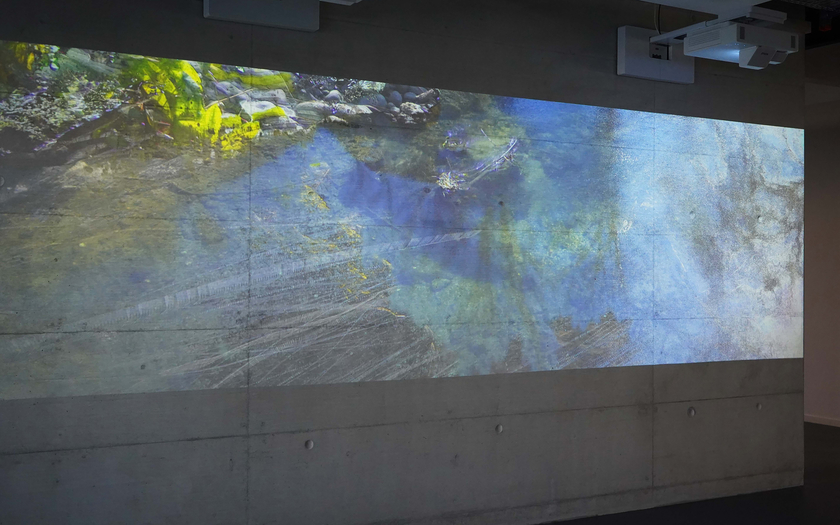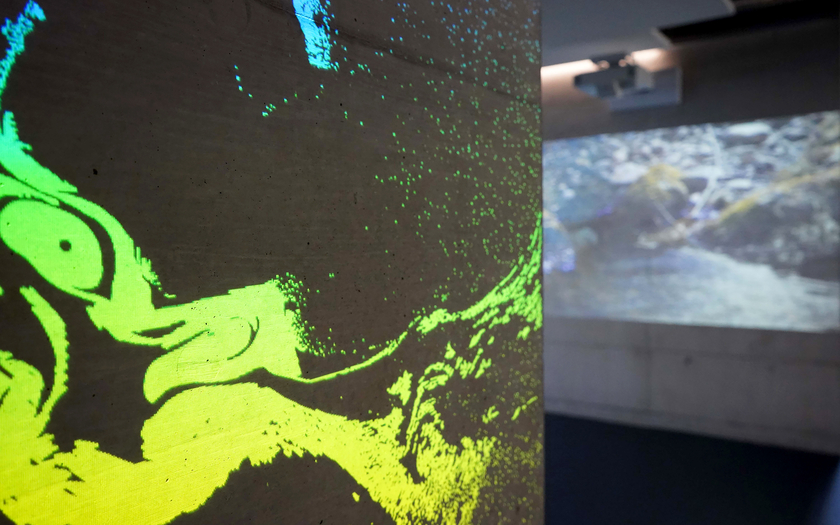FLUX - Art on the building
Aesthetic weather report in the FLUX building
About the imagery/video - Dual projection; one projection is based on live camera footage and the learning rules of a neuronal network; the simulation is based on Perlin noise, Navier-Stokes solvers and reaction diffusion kinetics, and parameterised using live measurements of oxygen saturation, temperature and turbidity.
The art installation entitled “Continuum” by Ursula Damm and Felix Bonowski is a generative dual projection. It draws on live data from the Chriesbach, the stream that flows past Eawag.
The two projections represent a particular “reality” of the Chriesbach and its flow over the course of a year. They both translate information on the seasonal fluctuations, colour pallets and physical principles of the stream into sensuous images that are reminiscent of impressionist and Japanese paintings. By bringing the outside inside – bringing the water into the FLUX building, the object of observation into the place of investigation – the installation aesthetically reflects the “continuum” of the stream and the function of the building.
The colour projection brings together images of the Chriesbach and its inhabitants
Real-time images from three cameras are projected alternately through a graphic shader based on the classic learning rules of a neuronal network that “remembers” colours in areas with high levels of activity. The resulting video is a collage that combines aspects of the Chriesbach’s visual appearance at different times and angles. Portraying the stream’s daily and seasonal changes, the images serve as a kind of aesthetic weather report.
The black-and-white projection is a live simulation of a river weaving its way through a rock-strewn valley. Starting from the basis of an ecosystem of nutrients, primary producers and grazing microorganisms that inhabit the river, the simulation portrays in digital form "what the world would look like if nature followed these rules." The parameters for the formulas that shape the landscape and determine the flow dynamics and the evolution of life in the simulation are constructed using values derived from actual real-time measurements of physical water properties.
Temperature, oxygen saturation and turbidity leave their mark
Measurements are taken at a station operated by the research institute, sited just a few feet from where the cameras look down on the stream. The correlations between the measurements and model parameters are selected to ensure that seasonal changes (temperature), diurnal rhythms (oxygen saturation due to photosynthesis), and occasional events (turbidity due to thunderstorms and construction works) leave their mark on the graphs. The simulation transitions from a valley with a few large boulders to a (virtual) riverbed with innumerable small pebbles - from one emergent biological pattern to another, from a slowly meandering river to a lively and powerful stream, portraying itself as an entity that is in constant flux.
At the right-hand edge of each projection, the image logic of the other projection encroaches, so that the colour data from the livestream and the patterns of the black-and-white simulation overlap. High-contrast movements in the colour projection (such as reflections or floating leaves) become lines, scratches and holes in the black-and-white projection. They appear as forces that extinguish organic life, thus destroying parts of the image. The poignant message is that no image and no "reality" stands alone, but can be questioned, disturbed or interpreted through a multitude of approaches.
Continuum
Art installation by Ursula Damm and Felix Bonowski, 2021
Curated by Yvonne Volkart
Commissioned by Eawag
“The aesthetics of the installation and its underlying concept very much appealed to the jury members, who appreciated the way the FLUX building and its immediate surroundings were so thoughtfully designed, with the stream and water lily sculpture denoting a place of flow as well as aquatic scholarship. The jury were impressed by the idea of making the Chriesbach the starting point, connecting the flow and continual evolution of the watercourse outside with the aquatic research and teaching inside.
They were also impressed with the dual nature of the design, which allowed both the water itself and the scientific gateway into its world to be experienced as a sensory phenomenon that is continually changing and that ultimately remains somewhat elusive. It is easy to imagine an observer losing themselves metaphorically in a river awash with colour and form, like a painting by Claude Monet. The jury agreed that the similarity to the painting lent by the walkway was not so much a problem as a potential prerequisite for a special experience.”
From the jury report, June 2019
About the artists
Ursula Damm started out her artistic career creating earthen sculptures as models of space and time embodied in a physical experience. In the 1990s, her installations reflected the geometric processes of settlement patterns. From 1995, her work became an interactive response to architecture, using video tracking technology. At the same time, she created numerous installations around the theme of the interchanging relationships of nature, science and civilisation. Ursula Damm has received several prizes, scholarships and grants for her work. She has exhibited at a number of festivals and exhibitions all around the world. Since 2008, she has held the Professorship for Media Environments at the Bauhaus University, Weimar.
Felix Bonowski studied molecular biotechnology in Heidelberg/Germany. He now lives and works as an artist in Berlin/Germany. His artistic work revolves around pattern creation by actor/environment interactions, on the boundary between mathematical system analysis and raw nature experience. The materials he uses range from moss, fish, robotic drawing machines, laser light all the way to mathematical simulations of fluid-movements.
Contact
Eawag
Überlandstrasse 133
8600 Dübendorf
Tel. +41 (0)58 765 55 11
Fax +41 (0)58 765 50 28
info@cluttereawag.ch


